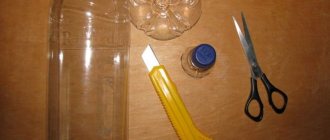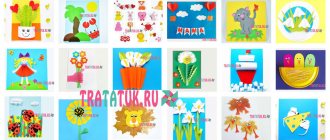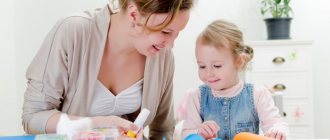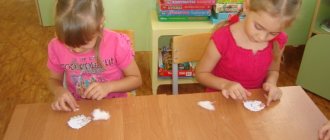Creating applications contributes to the development of fine motor skills and coordination of movements in a preschooler - skills that are later indispensable during school years. Children develop accuracy, perseverance, and taste. The application of mushrooms and berries will help the teacher solve another problem: to instill in children of different ages love and respect for nature.
- What you need for an applique on the theme of mushrooms and berries made from paper
- Application options for children and sample scenarios for conducting classes
- Junior group
- Middle group
- Senior group
- Video master class on creating the application “Mushrooms in a basket”
- Ready-made templates
- Tips and tricks
Notes on non-traditional drawing "On a mushroom meadow" in the junior group
Lyudmila Pasikova
Notes on non-traditional drawing "On a mushroom meadow" in the junior group
Drawing foam rubber printing using a stencil
"In the mushroom meadow "
Program content: Teach children to depict mushrooms using a stencil using the “printing”
foam stick.
Practice drawing vertical short straight lines with your finger from top to bottom to depict grass. Develop a sense of color and rhythm. Cultivate curiosity and interest in drawing .
Materials, tools, equipment: illustration depicting mushrooms , stencils of mushrooms , sample teacher, foam sticks, sheets of A-4 paper, gouache, napkins.
The teacher shows an illustration of mushrooms and reads a poem:
We'll go into the woods, we 'll find a fungus ,
Small, okay, in a smart hat. (O. Vysotskaya)
Don't hide, mushroom in the grass ,
I'll rip you off anyway!
Examines parts of the mushroom , specifies color and size.
Then he turns his attention to the sheets of stencils. “You have mushrooms living in your clearing . But where are they? They hide behind the windows. Let's find them together? I dip the stick into the white paint and tap it on the “window”
.
Like this. Knock-Knock! Try it yourself.” Children accompany their movements with the words: “Knock-knock-knock
.
The teacher helps fill out the entire lower part of the window. mushrooms lack ? Now let’s fill the upper part of the “window”
. At the end of the work, the stencils are removed. The teacher reads a poem:
Look, mushrooms have appeared !
Brown cap, solid belly
You see, this is dad, it’s easy to recognize him.
We tried our best and found mushrooms in a green meadow .
Application options for children and sample scenarios for conducting classes
Different ages of children involved in creative work imply different levels of complexity of crafts:
- younger age - a simple application from two or three ready-made templates;
- middle age - children learn to cut elements from blanks;
- older age (preparatory group) - application from composite elements.
Junior group
A simple application is made: a pair of mushrooms (large and small) are located in the middle of the sheet, a currant branch on the side, and grass at the bottom.
Materials for a lesson on appliqué on the theme of mushrooms and berries in the younger group (blanks cut out of paper):
- sheet of cardboard;
- cap and stem of large and small mushrooms;
- twig with berries;
- grass;
- glue in the form of a pencil.
The teacher prepares in advance a finished application, a nursery rhyme.
Procedure for conducting the lesson:
- Show the finished work.
- They read out a poem.
- They look at mushrooms and berries together with the children (questions like: “What is this growing in our clearing?”).
- Explain the structure of a mushroom (questions like: “What does our mushroom consist of?”).
- Explain what materials are prepared for creativity;
- They ask the children to show one by one the cap and stem of a large mushroom (they call it a mushroom - dad or big brother), then - a small one (son or little brother).
- The children are asked to place the blanks on a piece of paper. Note! Some of the group may place the appliqué elements inaccurately (for example, place the mushrooms too close to the edge of the sheet), so they need to explain that there is grass, mushrooms, and berries in the clearing, which means that all the blanks must fit on the sheet.
- They show how to apply glue to the workpiece and how to perform gluing.
- They start gluing (phrases like: “first we will glue the leg”, “then the hat”, “here are the berries”, “now there is grass in the clearing”).
- They examine the resulting applications and praise the children.
Middle group
An application is made of several mushrooms in a clearing. Mushrooms of different sizes, currant branch, grass.
Materials for the lesson for everyone in the group:
- sheet of cardboard;
- blanks made of colored paper: circles (for hats) and rectangles with drawn rounded edges (for legs);
- a branch with berries drawn on colored paper;
- glue;
- glue brush;
- napkins.
The teacher prepares a version of the finished application, rhymes, riddles on the topic, and music for the game.
Procedure for conducting the lesson:
1. They offer the game “Mushroom picker”. While the music is playing, they can frolic, and as soon as the music stops, squat down so that the mushroom picker does not find them and take them into the basket.
2. They say about mushrooms that they come in different shapes and sizes.
3. They explain that the shape of the cap depends on how you look at it: if from above, then a circle, if from the side, then a semicircle.
4. Explain how to use scissors to cut blanks.
Working with scissors requires care. During this part of the lesson, the teacher should not allow children to be distracted, spin, walk or run around the group.
5. They show how to get two mushroom caps from a circle: fold the circle in half, smooth the fold line with your fingers, unfold it and cut along the fold line.
6. Cut out the legs from the blanks. They show the children how to make a rounded cut: smoothly turning the left hand with the workpiece towards the right hand with scissors.
7. They show how to cut grass from a strip of green paper: make a series of cuts diagonally along the upper edge of the strip.
8. Children are taught to spread glue on the workpiece with a brush: a little glue is spread in a thin layer from the center to the edges of the part.
9. Glue the mushrooms (first the stem, then the cap), then the grass so that the mushrooms “peek out” from it. The last one to glue is the currant branch.
10. They examine the resulting clearings and praise them for their efforts.
Children are not always able to immediately apply the correct dose of glue to the workpiece. When gluing, excess glue protrudes beyond the edges of the part. It must be explained that in this case, its remains are carefully wiped off with a napkin.
Senior group
For classes in the senior group you will need the following set of materials:
- a sheet of thick paper (or cardboard) as a base;
- sheets of colored paper with drawn squares and circles;
- a sheet of paper with drawn outlines of whole mushrooms;
- a sheet of red paper (future berries), a sheet of green paper (for a branch of berries), a sheet of white paper (for dots of fly agaric);
- colour pencils;
- glue;
- glue brush;
- napkins.
The teacher prepares in advance a version of crafts, rhymes and jokes on the topic, colorful pictures of forests, forest edges, and different types of mushrooms (edible and poisonous).
The procedure for conducting the lesson.
- Children are given a “tour” through the forest using pictures.
- Explain the difference between edible, inedible and poisonous mushrooms. They explain that although poisonous mushrooms are not eaten, when walking in the forest they should not be kicked or knocked down with a stick, since they serve as medicine for animals and decorate the forest.
- They suggest choosing the color of paper for the caps (for example, for fly agaric - red, for edible ones - gray, brown).
- Cut out circles from selected sheets of paper - blanks for hats.
- They show how to make two hats from one circle: fold the circle in half, smooth the fold line well with your fingers, straighten it, cut the workpiece along the fold line.
- They show how you can get two legs from one square: fold the square in half corner to corner, iron the fold line with your fingers, use scissors to round all four edges of the rectangle, bend it and cut along the fold line. They say that this method of cutting is called paired, so you can get two identical appliqué parts.
- Cut out the currant berries. You need a lot of them, so they show you how to cut two or four berries at once: fold a sheet of red paper in half or four, draw a circle - a currant berry, cut this circle with scissors, getting two or four berries in one cut.
- Just like the berries, cut out white circles - fly agaric specks.
- They tell you how to cut out a whole mushroom using a ready-made template. They explain that this template is easier to color first and then cut out. Color the cap and stem with different colored pencils and cut out along the outline.
- Cut out a currant branch from a green sheet of paper according to a pre-drawn template.
- They show how to cut grass from a strip of green paper: make paired cuts diagonally along the upper edge of the sheet.
- Place the applique details on the base sheet. They say that complex parts (a currant branch with berries and a fly agaric cap with specks) can be glued in different orders: first prepare the entire part by gluing specks on the cap and berries on the branch, and then glue the part to the base, or in the reverse order.
- Glue all the prepared parts onto the base.
- They show a little secret: the currant branch can be slightly under-glued and bent a little. Then the application turns out to be voluminous and the currant branches sway like real ones.
Children often make the mistake of cutting off the cap from the stem of the mushroom. In this case, it is best to explain that what happened is easy to fix. To do this, glue the cap and stem of the cut mushroom separately.
On the topic: methodological developments, presentations and notes
Target. Teach the technique of smearing, i.e. pressing on the rolled ball with your index finger and pulling it up to obtain an image of grass; continue to teach yourself how to pinch off small ones.
Educational areas: cognition, communication, physical development. Goal: to consolidate and expand children’s ideas about spring, to cultivate a caring attitude towards nature; development of fine motor skills of the hands, development of...
Summary of a finger painting lesson in the first junior group Topic: “Let's decorate the Christmas tree” Types of children's activities: playful, communicative, cognitive-research, productive.
Summary of a finger painting lesson in the first junior group “Beautiful cup with polka dots” Irina Shishkina Summary of a finger painting lesson in the first junior group “Beautiful cup.
a lesson on sensory development on the topic “magic meadow”.
Learn to draw in unconventional ways - with your fingers.
Source
An example of a drawing lesson summary for a senior group on the topic “Mushrooms”
HE. Mishchuk “Drawing lesson on the theme “Amanita in the grass”
When a child draws, he transfers his pure soul to paper.
| Organizational educational activities | ||
| Kind of activity | Topic/Materials | Objectives/Program content |
| Drawing | "Mushrooms" Materials . Red, green and simple pencils, eraser, sketchbook sheets for drawing. | Learn to draw a fly agaric from its constituent parts (leg with skirt, cap). Clarify children's understanding of the structure of mushrooms: common and distinctive features. To develop an interest in learning about the world around us, to introduce them to edible and poisonous foods. |
| Lesson stage | GCD content | |
| Preliminary work | Look at pictures of mushrooms, talk about edible and poisonous ones, name them. Consider the peculiarity of the appearance of the fly agaric (bright red cap with white dots, skirt on a leg). | |
| Main part | Conversation on the topic The teacher tells the children that old man Lesovichok came to visit them today (brings in a doll and a basket of dummies). Lesovichok talks about the forest school “Pantry of Knowledge”, where animals study. And tomorrow they will come to class, and Lesovichok will tell them about mushrooms. He found many different mushrooms in the forest, but he did not find a very bright and beautiful mushroom, but very poisonous. The teacher invites the children to help Lesovich and draw fly agarics so that he can take their drawings to the forest school and tell them to the animals. The teacher invites the children to talk about mushrooms and show Lesovich that they also know a lot about them (shows pictures of mushrooms and asks questions about what they are called, what color the caps of boletus, boletus, boletus, and fly agaric are). He makes riddles about the fly agaric so that Lesovichok will also make them at his school. This mushroom grows in the forest. Don't put it in your mouth! It is not at all sweet, specks on the cap, red like a tomato, inedible... ( fly agaric). How good he is! He has a polka dot hat! This fungus grows in the forest, but I won’t bring it home! He is too quick to kill, Poisonous mushroom... ( fly agaric). The teacher asks a question about why you can’t collect fly agaric mushrooms. The teacher tells the children that now they will draw a fly agaric, but first they will play a game to remember all the types again. Game “Edible - Inedible” Explanation of the drawing scheme. | |
| Physical education minute | Gymnastics “Into the forest to pick mushrooms” All the little animals are at the edge of the forest (children walk in a circle, holding hands) They are looking for milk mushrooms and milk mushrooms. The squirrels were jumping, (the children are jumping) The squirrels were plucking. (pluck them) The fox ran, the foxes collected. (children run in a circle and collect them) The little bunnies jumped around and looked for honey mushrooms. (children jump, collect honey mushrooms) A bear passed, (children walk like a bear waddle) A fly agaric crushed. (children stomp their right foot) | |
| Final part (summarizing) | Let's tell Lesovich once again which ones can be collected and which ones cannot. What are their names? The teacher prepares a large sheet of whatman paper in advance, tinting it with a light green color, drawing bushes and grass as if in a forest clearing. Children lay out their drawings in the clearing, look at them, choose the best ones and give them to Lesovich. | |
Step-by-step drawing of a fly agaric
The teacher should pay special attention to explaining all the stages of drawing a fly agaric.
Step by step drawing | 1. Using a simple pencil, draw a vertical line in the center of the sheet, marking the edges of the cap and skirt on the leg. 2. Let's draw a leg that looks like a tree trunk, expanding at the bottom. The top of the cap has an arched shape, the bottom is a line with slightly raised edges. 3. Draw a skirt on the fly agaric leg on a pre-marked line, and circles on the cap. We erase the extra lines. 4. Color the hat with a red pencil, leaving the circles white. You can draw a wavy line at the bottom of the cap and shade it with vertical shading. Using a green pencil, draw the grass in which the fly agaric grows. |
The teacher shows pictures depicting edible mushrooms. Children name them and describe their appearance features.
Photo gallery: pictures of edible mushrooms to show to children
|
The teacher shows pictures of poisonous mushrooms. Children name them and describe their appearance features.
Application with drawing elements “Mushroom clearing” in the second junior group
Liliya Nasretdinova (Fatiykhova)
Application with drawing elements “Mushroom clearing” in the second junior group
Author : Liliya Nasikhovna Fatykhova, teacher of the first qualification category of MADOU No. 100 “Firebird”
city of Naberezhnye Chelny.
Goal: to develop imagination and interest in artistic creativity.
-learn to depict mushrooms using the appliqué technique : create images of contrasting sizes from ready-made elements;
— enrich children’s vocabulary and develop their speech;
— practice the technique of painting with gouache paints .
- cultivate curiosity and interest in nature;
- stimulate children's creative activity;
- cultivate independence, confidence, initiative.
— Develop communication skills, cognitive processes (mental operations, arbitrariness and concentration, memory capacity and others).
— Maintain children’s interest in the discipline being studied.
— Develop a sense of color, shape, size and composition.
Materials, tools, equipment.
Sheets of white paper for composing the composition, ready-made forms for gluing mushrooms - rectangular or oval legs and round or semicircular caps (2 sets of elements each, contrasting in size, glue, 2 brushes, gouache paints, cups (jars)
with water, paper and cloth napkins, oilcloths.







